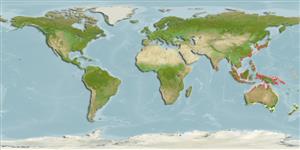分類 / Names
俗名 | 同種異名 | Catalog of Fishes(屬, 種) | ITIS | CoL | WoRMS | Cloffa
Environment: milieu / climate zone / depth range / distribution range
生態學
海洋 礁區魚類; 深度上下限 5 - 20 m (Ref. 90102). 熱帶
Indo-West Pacific: India east to Sagami Bay, Japan and China. A new record was reported from southern Indonesia (Ref. 5978).
印度-西太平洋: 印度東至在日本的相模灣而且南至中國。 一個新的記錄被記錄自印尼南部。 (參考文獻 5978)
大小 / 重量 / 年齡
Maturity: Lm ? range ? - ? cm
Max length : 14.0 cm TL 雄魚/尚未辨別雌雄; (Ref. 559)
背棘 (總數) : 10; 背的軟條 (總數) : 12; 臀棘: 3; 臀鰭軟條: 6. Distinguished from C. aprinus by the bright yellow coloration when viewed underwater (Ref. 48636).
與 C. aprinus 區分了藉由鮮黃色的顏色當看在水中的.(參考文獻 48636)
Occurs on rocky cliffs in deep water (Ref. 9710). Also inhabits muddy substrates in protected bays where wave action has no influence (Ref. 48636). Solitary (Ref 90102).
在深水中生活於岩石的懸崖。 (參考文獻 9710) 也在遮蔽的內灣中居住於泥質底部在哪裡不受波浪影響.(參考文獻 48636)
Life cycle and mating behavior
成熟度 | 繁殖 | 產卵場 | 卵 | 孕卵數 | 仔魚
Bi-directional sex change has been confirmed for this species (Ref. 103751). Sexual pattern seem to be intermediate between simultaneous and sequential hermaphroditism: individuals, at least under conditions of captivity, have the capacity to change sex in either direction, from functional male to functional female, or vice versa (Ref. 31569).印度-西太平洋: 印度東至在日本的相模灣而且南至中國。 一個新的記錄被記錄自印尼南部。 (參考文獻 5978)
Masuda, H., K. Amaoka, C. Araga, T. Uyeno and T. Yoshino, 1984. The fishes of the Japanese Archipelago. Vol. 1. Tokai University Press, Tokyo, Japan. 437 p. (text). (Ref. 559)
IUCN 瀕危狀態 (Ref. 130435: Version 2024-1)
無危 (LC) ; Date assessed: 18 August 2023
人類使用
工具
特別的報告
下載 XML
網路資源
Estimates based on models
Preferred temperature (Ref.
123201): 21.4 - 29.3, mean 28.7 °C (based on 1745 cells).
Phylogenetic diversity index (Ref.
82804): PD
50 = 0.5039 [Uniqueness, from 0.5 = low to 2.0 = high].
Bayesian length-weight: a=0.01445 (0.00715 - 0.02923), b=3.07 (2.89 - 3.25), in cm total length, based on LWR estimates for this species & (Sub)family-body (Ref.
93245).
營養階層 (Ref.
69278): 4.0 ±0.67 se; based on food items.
Fishing Vulnerability (Ref.
59153): Low vulnerability (10 of 100).
